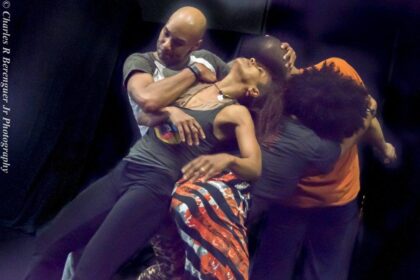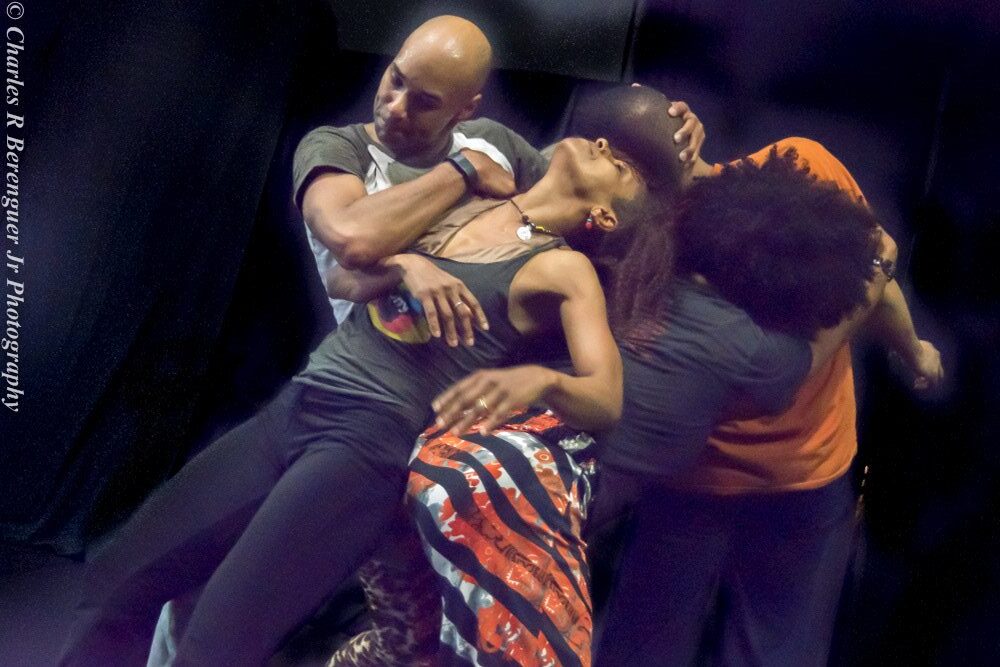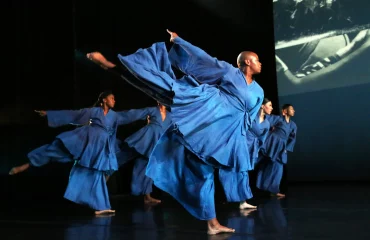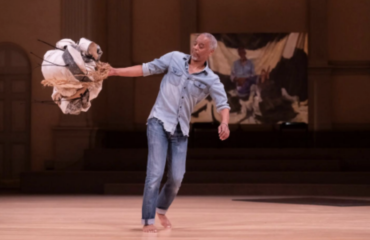
Call it a village; an almost careless yet embracing hospitality. I experienced its warmth the moment I entered through the old wooden red chapel door wreathed with a drone cloud of bumblebees and stood at the north end of the Gothic Revival peaked nave of what began life in 1868 as the chapel and Sunday school of the 1855, renovated 1879, St. Peter’s Episcopal Church, which stands just to the north on the same campus across a patch of the graveyard that dates to circa 1702 and surrounds both landmarked buildings. Adding another chapter to this history, the chapel has housed BAAD! (Bronx Academy of Arts and Dance) since the venue’s move there in 2014 from the more recently landmarked American Banknote Printing Plant building in Hunts Point where it had pioneered an artists’ community that helped revitalize that neighborhood. Its presence amid the gravestones seemed to both provoke and fulfill a similar promise for the colonial crossroads of Westchester Square and the entire East Bronx.
The easy acceptance of three young children among the multigenerational assemblage of folks in chairs on small risers lining the long walls of the nave on either side of what would become the central performance area enhanced my perception of a sense of community in this space. Facing me, across the long central corridor of the performance area, sat a panel of artist-presenters along the south wall who included host/moderator Aimee Meredith Cox, Melanie George, Millicent Johnnie and Hank Smith. I had walked into the last 20 minutes of the first course of what I had described to my Dancing Matters colleagues as a four-course meal for the soul, only the last segment of which involved actual food.
 Image description: nia love leans back with Darrell Jones holding her shoulder. She is wearing a black tank top and black pants. He is wearing a gray t-shirt with black short sleeves. Photo by Charles R. Berengeur Jr.
Image description: nia love leans back with Darrell Jones holding her shoulder. She is wearing a black tank top and black pants. He is wearing a gray t-shirt with black short sleeves. Photo by Charles R. Berengeur Jr.
The question the panel along the south wall sought to address: “How has improvisation been a technology for Black thriving?” carried through the entire event and could be said to have been either eleven, 404 years or millennia in formulation. The May 13 unfolding marked the last of a year long celebration of the 10th anniversary of the Dancing While Black series co-directed by Kayla Hamilton, Marguerite Angelica Monique Hemmings, Paloma McGregor and Joya Powell alongside production and thought partner Shalonda Ingram and her team at Nursha Project. The 10th anniversary had begun with a similar three evening series a year ago, which like this year’s edition, began with two virtual presentations followed by a culminating live event at BAAD.
As the members of the panel shared their experiences and thoughts, a just over one year old roamed freely near me in and out of the performance area engaged and contained as occasionally appropriate by not only his mother but by other listeners on either side of the nave, while two somewhat older girls sat, sidled or slid between the knees of other women, one on each set of chairs and risers. The scene, reminiscent of that of a church during the liturgy of the word, served as the hors d’oeuvres.
While this testimony represented only the appetizer, the main course soon arrived as consecration when musician Jocelyn Pleasant on percussion and other instruments called forth the main celebrants Christal Brown, Lacina Coulibaly, Ana “Rokafella” Garcia, Nia Love, Dianne McIntyre, Jason Samuels Smith, and Marlies Yearby to occupy and sanctify the center of the room with an extended structured improvisation. Tolstoy wrote of art as “a human activity consisting in this, that one … consciously, by means of certain external signs, hand on to others feelings <they have> lived through, and that other people are infected by these feelings and also experience them.” Even in the occasional awkward moments this performance manifested from time to time, the cross generational ensemble made these words flesh in ways that increasingly involved sharing with one another as well as those if us watching. In this Smith’s polyrythmic tapping and Rokafella’s breaking lent an extra breadth to the scope to the infectiveness of the dancing, but each of the others added her or his own flavor to the gumbo that we tasted as watchers.
Communion came as a kind of dessert as most of these witnesses became dancers themselves in a two hour dance party with active dj that followed the improvisational presentation. The entire six or more hour event leaned into the sense of communal involvement supportive of exploration within movement that one imagines that more than a decade of the Dancing While Black project has embodied and that the programming at BAAD! seems to epitomize. The full title of this final session had been given as DWB: Future: How We Thrive. As a harbinger of a possible post pandemic arts ecology the title seemed apt and its generous execution pointed with hope to a possible pathway.
As each of the Dancing Matters attendees danced their fill at the post party, we retired in twos and threes for our digestif discussion to the Mexican place that BAAD! Artistic Director Arthur Aviles had recommended on Westchester Square, one of seven La Estrellita’s whose burgeoning success hints at so much about the long slow recovery from lockdown evident in the New York City of this moment. We had invited the artists to join us at dinner and welcomed Rokafella along with her husband and partner Kwikstep to our table. Bronxite Rok did the majority of the ordering en español.
BAAD! and its borough might be seen as a place of pilgrimage among a large portion of the audience for live dance much as former Jacob’s Pillow Artistic Director Liz Thompson once characterized her campus in Becket, Massachusetts, that transfigured an old New England farm. One of our number intimated, in the course of our sojourn, that the last time he’d visited Westchester Square had been to leaflet against the draft during the U.S. war in Vietnam. I thought about that as I explored the cemetery surrounding BAAD! and St. Peters that contains graves from every U.S. conflict since its inception as well as about Myanmar, Sudan and Ukraine.
To arrive here for this extraordinary adventure from Brooklyn, one had had to allow for weekend subway work that had the number 6 train terminating at Parkchester, three stops short of East Tremont/Westchester Square. Our group, however, had shown the determination to reach this transformed village to embrace its history and unfolding future and be embraced by it in return. Mark Twain wrote of travel as, “fatal to prejudice, bigotry, and narrow-mindedness, and many of our people need it sorely on these accounts.” Travel, like dancing, involves movement. I hope that my DM colleagues found this travelling as moving as I did, and maybe, whether they have or not, they will say so in writing on our Facebook page.




Debes estar registrado para introducir un comentario.